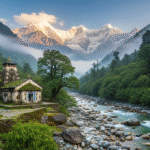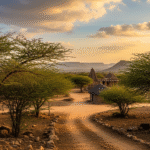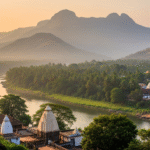While places like the Sundarbans National Park, which is huge, and the famous Ranthambore National Park capture lots of attention, India has many secret wildlife spots. These places are full of different kinds of life. From very high places with grass to forests that are full of trees. They are home to animals that are very rare and might disappear soon. It’s a chance to see wildlife away from the usual paths.
In places like Gujarat’s Khijadiya Bird Sanctuary, you can see over 300 kinds of birds that come from other places. Then there’s Rajasthan’s Tal Chhapar Sanctuary, where blackbucks live, and many birds visit in September. Each place tells a special story about nature’s beauty and strength. They let us get close to the wild and help protect India’s nature story. To see these hidden spots, explore these special places for adventure and calm.
These sanctuaries mix protecting nature with helping local people. Meeting these local heroes gives us great stories about nature and people. It helps us understand how to keep nature safe while living near it. This story helps more people want to protect our natural world.
Key Takeaways
- Overshadowed by renowned parks, hidden wildlife sanctuaries in India offer a serene retreat into unspoiled nature.
- Each sanctuary unfolds unique ecosystems housing a wealth of rare and endangered species.
- Seamless eco-tourism and conservation efforts permeate these off-the-beaten-path animal reserves and involve local communities.
- These gems highlight the urgency for biodiversity conservation and the opportunity for intimate nature encounters.
- Learning from local protectors enriches the travel experience and augments efforts in wildlife management and habitat preservation.
Kabini Wildlife Sanctuary: Karnataka’s Untouched Haven
Nestled along the Kabini River, this sanctuary is a gem of conservation in India. It’s a place of rich biodiversity set in Karnataka’s lush views. Here, animals like majestic elephants and hidden leopards find a safe home.
A key spot for ecotourism in India, Kabini draws those who love nature and photography. The sanctuary is known for its untouched natural beauty. It works hard with local communities to keep wildlife and nature thriving.
Eclectic Fauna and Avian Delights
Kabini is home to Bengal tigers, Indian bison, and over 250 bird species. Birdwatchers and photographers from all over love this place. They come to see the beauty of these creatures in the wild.
Unique Safari Experiences
Visitors can explore by jeep, boat, or even on elephant back. These safaris let you get close to animals. You might see a Bengal tiger or watch peacocks dance.
Conservation Efforts and Community Engagement
The sanctuary works hard to protect its environment and animals. Local communities help a lot in these efforts. They help keep nature in balance and teach others about the importance of conservation.
Statistical Insights:
| Activity | Statistic | Details |
|---|---|---|
| Peacock Sighting | Multiple perches | Observed on Elephant Proof Trench fencing |
| Tiger Sighting | 5 KM | Distance covered to reach sighting location |
| Leopard Interaction | 30 Minutes | Magical moments spent with leopard named Scarface |
| Bird Watching | Diverse | Species spotted include Malabar Pied Hornbills and Indian Peafowls |
The sanctuary’s ecosystem is thriving thanks to its focus on ecotourism. Kabini is a special piece among Indian wildlife sanctuaries. It shows us a bright path for conservation and sustainable travel in India.
Nagzira Wildlife Sanctuary: Maharashtra’s Secret Biodiversity Hub
Located in the green lands of Maharashtra, the Nagzira Wildlife Sanctuary plays a big role in conservation. It homes a big part of biodiversity in India. Though small, it’s home to 34 mammal species and 166 bird species. This includes both local and visiting birds. This makes it a top lesser-known nature sanctuary.
At Nagzira, visitors can enjoy different activities. They can watch many birds in their natural homes. Or, learn at the sanctuary’s museum and center. The sanctuary offers much more than just a simple walk.
People love the park’s watch towers. They offer wide views and a chance to see the beauty and peace of this hidden gem.
This sanctuary is a haven for lovers of Earth’s living things. Keeping such places safe is key for nature’s balance and for species living there. As people take up more space, saving these lesser-known nature sanctuaries is very important. This is especially true in crowded places like India.
Being a part of places like Nagzira helps keep biodiversity going. It also makes more people know and join in conserving nature. This way, we can keep these beautiful places safe for the future.
To learn more about how India works to save such places, check out Environmental Protection Initiatives.
The Enchanting Dibru Saikhowa National Park of Assam
Assam is home to the green Dibru Saikhowa National Park. It shelters rare species and offers trekking adventures. Covering 340 sq km, this park plays a big role in saving biodiversity and supporting eco-tourism.
Spotting the Rare White-Winged Wood Duck
The park is known for its white-winged wood duck. It’s a haven for over 500 types of birds. Bird-watchers and nature lovers adore the park’s bird variety.
Eco-Tourism Initiatives and Homestay Experiences
Eco-lodges and homestays are found throughout. They offer experiences close to nature. Environmental impact is minimized. The park’s trekking paths welcome those eager to explore. It also provides mountain hiking for thrill-seekers.
| National Park | Total Area (sq km) | Notable Species | Unique Feature |
|---|---|---|---|
| Dibru Saikhowa National Park | 340 | White-Winged Wood Duck, Gangetic River Dolphins | Unique wetland ecosystem |
| Orang National Park | 78 | One-horned Rhinoceros, 50+ species of fish | Rhino sanctuary of Assam |
| Kaziranga National Park | Varies | Indian One-horned Rhinoceroses | UNESCO World Heritage Site |
| Manas National Park | Varies | Rich biodiversity | Shared boundary with Bhutan |
| Nameri National Park | Varies | Varied Avian species | Boundary with Arunachal Pradesh |
Dibru Saikhowa stands out for eco-tourism. It’s known for eco-lodges and nature care. This park is a top example of tourism and conservation working together in Assam.
Khijadiya Bird Sanctuary: Gujarat’s Avian Wonderland
Khijadiya Bird Sanctuary is in beautiful Gujarat. It is perfect for people who love nature and birds. Over 300 types of birds, including migration birds, live here.
The sanctuary has many different landscapes like mangroves and grasslands. These areas help various birds to live and thrive. It’s a top spot for those who love green places in Gujarat.
Khijadiya is more than watching birds. It has trails and places to see birds closely. It is near Narara Marine National Park. This adds more types of animals to see.
The sanctuary works hard to protect birds and their homes. It helps endangered birds stay safe. This makes Khijadiya very important for nature protection.
| Bird Species | Estimated Numbers | Conservation Status |
|---|---|---|
| Northern Pintail | 250+ | Least Concern |
| Common Teal | 300+ | Least Concern |
| Black-tailed Godwit | 150+ | Near Threatened |
Khijadiya Bird Sanctuary is beautiful and teaches about nature. It shows how important it is to keep nature and animals safe. Everyone is invited to learn and help protect birds and nature.
Tal Chhapar Sanctuary: Rajasthan’s Blackbuck Oasis
Tal Chhapar Sanctuary is in Rajasthan’s Churu district. It’s a key place for tourism and saving wildlife. Although small, it plays a big role in protecting the beautiful blackbuck. It also helps in saving India’s wildlife and supporting birds.
Thorn Forest Ecosystem and its Inhabitants
The sanctuary’s thorn forests are special. They provide a home for animals and birds that love the desert. It has many blackbucks and lots of bird types. This makes it important for birds. In winter, birds from far away visit, which attracts many people.
Community-Led Conservation and Sustainable Tourism
Local people and eco-friendly tourism help Tal Chhapar a lot. The community helps protect this special place. This way, tourism doesn’t hurt the environment but helps the local economy. This approach is a great example for others around the world.
Visitors can go on safaris or walks, led by people who know the area well. This lets them see the sanctuary’s animals up close. It teaches them why saving nature is key.
| Sanctuary | Area (sq km) | Notable Wildlife |
|---|---|---|
| Tal Chhapar Wildlife Sanctuary | 7.19 | Blackbucks, Desert Foxes, Bird species |
| Ranthambore National Park | 1,334 | Tigers, Leopards, Crocodiles |
| Sariska Tiger Reserve | 881 | Tigers, Sambar Deer, Hyenas |
| Kumbhalgarh Wildlife Sanctuary | 578 | Wolves, Leopards, Sloth bears |
| Keoladeo National Park (Bharatpur) | 29 | Diverse Bird Species, Sambar Deer, Python |
Tal Chhapar Sanctuary is great for wildlife and birds. Its focus on eco-tourism helps animals and people. It shows that even a small place can make a big difference. It’s good for both animals and helping communities.
Dachigam National Park: Srinagar’s Alpine Treasure
Dachigam National Park lies in Kashmir’s heart. It’s a beautiful natural area that welcomes wildlife and visitors. The park is great for seeing rare animals and for taking wildlife photos. It covers 141 square kilometers. You’ll find forests, hills, and meadows here. It’s perfect for seeing and taking pictures of animals in the wild.
The Majestic Fauna of High Altitudes
The park is home to the Hangul deer, which is very rare. You can also see leopards, Himalayan black bears, and lots of birds here. Its location in Kashmir makes it very important. People can get close to animals that live in high places.
Exploration Opportunities and Photography
If you love taking photos of wildlife, this place is amazing. There are over 150 kinds of birds. Photographers will love it. The park offers safaris and treks with guides. Visitors can explore safely. And they’ll learn to care for nature.

| Sanctuary | Area (sq km) | Entry Fee (INR) | Unique Features |
|---|---|---|---|
| Dachigam National Park | 141 | 25 for Indians, 50 for Foreigners | Home to Hangul deer, Alpine landscapes |
| Hokersar Wildlife Sanctuary | 13.75 | Free | Migratory birds from Siberia & Central Asia |
| Hirpora Wildlife Sanctuary | 341 | 20 for all visitors | Diverse mammal species and lush forests |
| Lachipora Wildlife Sanctuary | 32 | 15 for Indians, 75 for Foreigners | Refuge for endangered species |
| Overa Aru Wildlife Sanctuary | 511 | 30 for Indians, 80 for Foreigners | Rich in flora and fauna diversity |
Dachigam is open from dawn till dusk. It has a small entry fee. This makes it easy for everyone to enjoy nature and see wild animals. It’s a great place for taking photos or going for a peaceful walk. Dachigam National Park is a top place to visit in Srinagar.
National Chambal Sanctuary: A Riverine Ecosystem’s Legacy
The National Chambal Sanctuary lies along the Chambal River. It’s a key site for preserving river ecosystems. It’s home to endangered wildlife in India, across 5,400 square kilometers in three states. Here, species like the river dolphins find a safe home.
This sanctuary is home to the gharials and the Mugger crocodile, once nearly gone. Now, they’re doing better, thanks to the Wildlife Protection Act of 1972. River dolphins add to its charm, showing it’s a special wildlife haven in India.
But, this place faces big challenges, like habitat harm, pollution, and conflict between humans and animals. Protecting this area is key. It helps keep the wildlife and unique river ecosystems safe and sound.
Here is a glance at some of the critical data about the sanctuary:
| Sanctuary Name | Area (sq km) | Key Species |
|---|---|---|
| National Chambal Sanctuary | 5,400 | Gharials, River dolphins, Red-crowned roof turtle |
| Bandhavgarh National Park | 450 | Various wildlife including tigers |
| Kanha National Park | 940 | Tigers, Leopards, Barasingha |
Protecting the National Chambal Sanctuary helps save many animals. It’s a great example of how to care for river habitats. People can visit for boat safaris or walks, and learn about the river’s life.
The Sanctuary is beautiful and wild. Its conservation stories show the value of protecting India’s river habitats.
Hidden Wildlife Sanctuaries in India: Achanakmar Tiger Reserve’s Wild Charm
The Achanakmar Tiger Reserve is in Chhattisgarh’s heart. It shows how well biodiversity conservation works under Project Tiger. It’s a key home for the Bengal Tiger and many other important species.

This reserve plays a big role in Project Tiger. The project works to save the tigers in India. Thanks to this effort, the number of tigers in Achanakmar is growing. This helps the area’s plants and animals too.
Project Tiger Success Stories
The reserve has great ways to manage and stop poaching. More tigers live there now. This shows how saving one of earth’s cool predators can work.
Spotlight on Chhattisgarh’s Ample Biodiversity
There’s more than Bengal tigers in Achanakmar. You can find Wild Bison and Leopards too. It’s a key spot for saving different kinds of life. It helps keep the area’s animal genes diverse.
| Sanctuary Name | Notable Species | Total Area |
|---|---|---|
| Achanakmar Tiger Reserve | Bengal Tiger, Wild Bison, Leopard | 551.55 sq km |
| Pilibhit Wildlife Sanctuary | Over 127 animal species, 500 bird species | Not Specified |
| Ranthambore National Park | Tigers, Sloth Bears, Hyenas | 1,134 sq km |
| Sunderbans National Park | 400 Tigers | 2,585 sq km |
Achanakmar helps in India’s big push to save biodiversity. It’s good for big and small creatures. It keeps nature in balance. And it’s great for science and visiting nature lovers.
Katarniaghat Wildlife Sanctuary: Uttar Pradesh’s Wetland Wonder
Located in Uttar Pradesh, the Katarniaghat Wildlife Sanctuary is a vibrant example of the Terai ecosystem. It provides a lush home for many plants and animals. This place is key for saving endangered species in its vast wetlands and thick forests.
Rare Turtles and Gharial Sightings
The sanctuary is known for its rare turtles and gharials. These animals are important to wetland sanctuaries. They help keep the area’s ecology balanced. Seeing gharials sunning on riverbanks is both common and amazing. It shows us why having safe places for wildlife matters.
Community’s Role in Wildlife Management
The local community near Katarniaghat Wildlife Sanctuary helps protect it. Their hard work is essential for keeping the sanctuary safe. It makes sure this place stays a hub for saving nature in the Terai ecosystem.
| Species | Count | Conservation Status |
|---|---|---|
| Rare turtles | Varies | Endangered |
| Gharials | Increasing | Critically Endangered |
| Gangetic Dolphins | Scattered populations | Endangered |
The green scenery and special animals of Katarniaghat draw nature lovers. It shows why wetland sanctuaries are so important for nature and wildlife conservation in India. The sanctuary not only saves the area’s natural beauty but also teaches us to live well with wildlife.
Conclusion
India is home to many secret natural places. Pobitora Wildlife Sanctuary is a big area that protects the Indian one-horned rhinoceros. This sanctuary shows how conservation work in India is helping nature.
The success of places like Kaziranga and Ranthambore shows the power of protecting nature. Visitors can see amazing animals up close in Pobitora. They can also enjoy eco-friendly boat rides in Periyar.
India started protecting wildlife in 1936 with Corbett National Park. Now, there are many parks, like Sundarbans National Park, that keep ecosystems safe. These parks let people help protect animals and nature.
The parks protect many animals, not just rhinos or tigers. They keep the land and its creatures safe. When people visit places like Kanha Tiger Reserve or Sundarbans, they follow the path of famous conservationists.
India supports living together with nature responsibly. Traveling to these wild places helps protect them for others in the future. By traveling this way, people join the global effort to save our planet’s natural beauty.
FAQ
What types of ecosystems can be found in India’s hidden wildlife sanctuaries?
India has many secret wildlife spots. They have different areas from high grasslands to lush forests. These places are home to rare animals and offer special travel experiences.
Can visitors participate in wildlife conservation efforts at Kabini Wildlife Sanctuary in Karnataka?
Yes, at Kabini Wildlife Sanctuary, people can help save wildlife. They join locals in eco-friendly projects. You can go on safaris and learn how to protect nature.
Are there bird watching opportunities in Nagzira Wildlife Sanctuary in Maharashtra?
Yes, Nagzira Wildlife Sanctuary is perfect for bird lovers. It has 166 types of birds, including ones that fly long distances. It’s a great place for watching birds and learning about wildlife.
What unique animals can be seen at Dibru Saikhowa National Park in Assam?
Dibru Saikhowa National Park has rare white-winged wood ducks among many fish types. It is focused on saving different life forms. You can stay in eco-lodges and explore nature trails.
Is Khijadiya Bird Sanctuary in Gujarat suitable for eco-tourists?
Yes, Khijadiya Bird Sanctuary is fantastic for eco-tourists. With over 300 bird types, it’s a bird watcher’s dream. You can see how birds live and enjoy the nature around.
How does Tal Chhapar Sanctuary in Rajasthan contribute to conservation?
Tal Chhapar Sanctuary leads in nature saving and green travel. It helps save blackbucks and birds, while keeping its natural area healthy.
What type of wildlife can be experienced at Dachigam National Park in Srinagar?
Dachigam National Park is home to bears, leopards, and deer. It offers many adventures like trekking. This park is great for animal lovers and explorers.
Are there endangered species to be seen at National Chambal Sanctuary?
National Chambal Sanctuary protects rare animals like the red-crowned turtle. It’s famous for its unique river life. This sanctuary is a treasure in India’s wildlife.
What is unique about Achanakmar Tiger Reserve’s approach to biodiversity conservation?
Achanakmar Tiger Reserve is part of a big tiger saving project. It tells success stories of saving tigers and other animals. Visitors can enjoy birdwatching and explore old sites.
How does the Katarniaghat Wildlife Sanctuary in Uttar Pradesh preserve its wetland ecosystem?
The Katarniaghat Wildlife Sanctuary saves its land by managing water areas and forests. It’s home to rare creatures like turtles. Locals play a big role in keeping the place safe.
Is it possible to see snow leopards and bharals in Indian wildlife sanctuaries?
Yes, Changthang has snow leopards, and the Great Himalayan Park has bharals. These places let visitors see rare species in the wild. They offer special experiences with nature.










